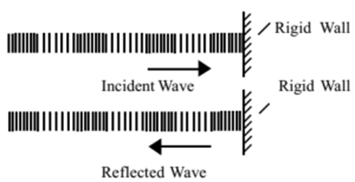Science > Physics > Wave Motion > Reflection of Waves
In this article, we shall study the reflection of waves at the boundary of the denser medium and rarer medium. Wave in a medium may be defined as the disturbance moving through the medium without change of form. e.g. ripple in water formed due to dropping a stone in water.
Reflection of a Wave:
When a wave travelling in a homogeneous medium meets a boundary of some other medium, it has a tendency to travel in the opposite direction. This phenomenon is called the reflection of the wave (or energy). Both light waves (transverse waves) and sound waves (longitudinal waves) exhibit this phenomenon. As the wavelength of a light wave is very very small of order 10-10 m, hence it can be reflected from a small surface. While the wavelength of a sound wave is large of order 10-3 m, hence it requires a large surface for reflection.
The light waves (transverse waves) and sound waves (longitudinal waves) both obey the laws of reflection. Echo is an example of the reflection of sound.
Reflection of Sound Waves from Curved Surface:

Reflection of sound waves from a curved surface can be demonstrated by an arrangement as shown in the figure. The concave reflectors are arranged parallel to each other such that they have the common axis and kept apart. A clock is placed at the focus F1 of reflector M1 and a funnel tube is arranged at the focus F2 of reflector M2. Sound waves diverge from the clock and are incident on reflector M1 and after reflection move parallel to the common axis. They are incident on reflector M22 and after reflection gets converged at the focus F2 of reflector M2 and can be heard through funnel tube.
Reflection of Longitudinal Waves (Sound Waves)
A progressive wave is a wave in which the medium particles are vibrating in the direction parallel to the direction of propagation of the wave is called a longitudinal wave. e.g. sound wave. Longitudinal waves propagate in a form of compressions and rarefactions.
At a Boundary of a Denser Medium:

Suppose that longitudinal waves in air (sound waves) are incident normally on a rigid wall. When a compression strikes the wall, it exerts a force on the wall. But as the wall is rigid, it exerts an equal and opposite force on the layer of air in compression and thus pushes the compression in the backward direction. Thus a compression travelling towards the right is reflected as a compression travelling towards the left. The displacement of a medium particle in the reflected wave is in the opposite direction to the displacement of the particle in incident wave. Thus, there is a phase difference of π radian or 180° between the incident wave and the reflected wave. Similarly, incident rarefaction is reflected as a rarefaction.
At a Boundary of a Rarer Medium:

Suppose that a longitudinal wave travelling in a denser medium is incident at the boundary of a rarer medium. If compression in the incident wave strikes the surface of separation (e.g. air at the open end of a pipe) then due to the high pressure of compression, the surface of separation is pushed back. As the particles of air at the open end of a pipe are free to move, the surrounding air goes away quickly and compression is converted into a rarefaction before the wave is reflected. Thus, the compression after reflection at a rarer medium returns as a rarefaction. Thus no phase change takes place when a longitudinal wave is reflected from the surface of a rarer medium. Similarly, incident rarefaction is reflected as a compression.
Reflection of Transverse Waves:
A progressive wave is a wave in which the medium particles are vibrating in the direction perpendicular to the direction of propagation of the wave is called a transverse wave. e.g. the wave produced in a rope by tying the rope at one end to a rigid wall and jerked at the other end. A transverse wave propagates in the form of crests and troughs.
At a Boundary of a Denser Medium:

Suppose that one end of a string is rigidly fixed to a wall at P, Transverse waves are produced in the string and they travel towards the wall. When the crest reaches the fixed end P, it exerts an upward force on the support but the support is not free to move. By Newton’s third law of motion, it exerts an equal and opposite reaction on the string and sends the pulse backwards. This is the reflected wave. Since the displacement at P is zero, the upward motion is cancelled by a downward motion. Hence a trough is formed on reflection Thus after reflection at a denser medium, a crest returns as a trough i.e. there is a phase change of π radian or 180° between the incident wave and the reflected wave. Similarly, a trough is reflected as a crest.
At a Boundary of a Rarer Medium:
If a crest of a transverse wave, in a denser medium, is incident at a point of a rarer medium, as the particles of rarer medium are free to vibrate, it will displace the particle at the point of incidence in the upward direction and after reflection from the rarer medium, a crest returns as a crest or a trough returns as a trough. Thus there is no change of a phase when a transverse wave is reflected from a rarer medium.

Previous Topic: Numerical Problems on Progressive waves
Next Topic: Formation of Beats
2 replies on “Reflection of Waves”
Uzma
perfect..